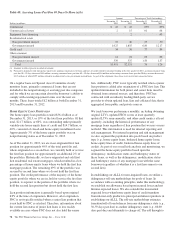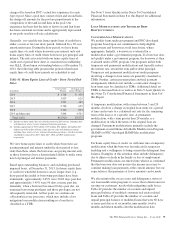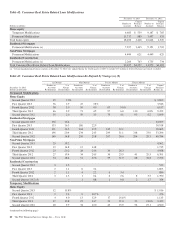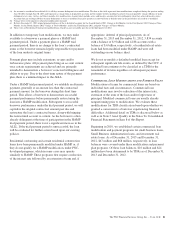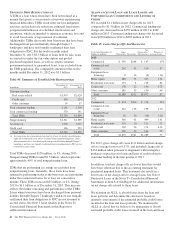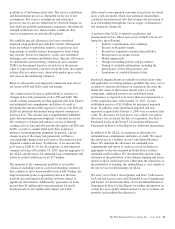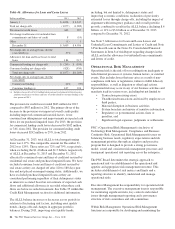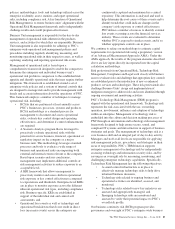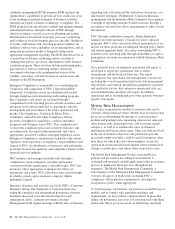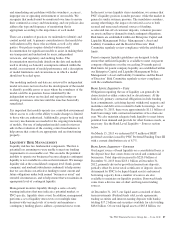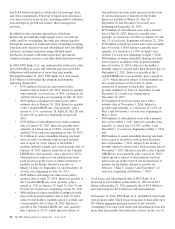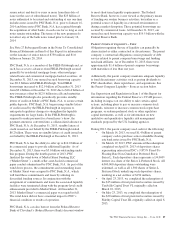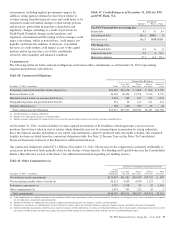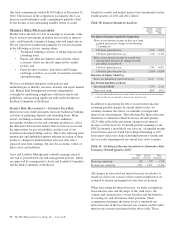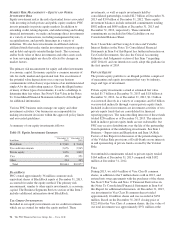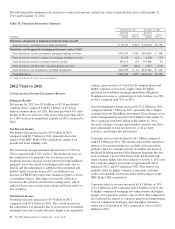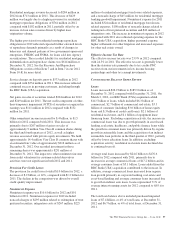PNC Bank 2013 Annual Report Download - page 105
Download and view the complete annual report
Please find page 105 of the 2013 PNC Bank annual report below. You can navigate through the pages in the report by either clicking on the pages listed below, or by using the keyword search tool below to find specific information within the annual report.and remediating any problems with the soundness, accuracy,
improper use or operating environment of our models. We
recognize that models must be monitored over time to ensure
their continued accuracy and functioning, and our policies also
address the type and frequency of monitoring that is
appropriate according to the importance of each model.
There are a number of practices we undertake to identify and
control model risk. A primary consideration is that models be
well understood by those who use them as well as by other
parties. Our policies require detailed written model
documentation for significant models to assist in making their
use transparent and understood by users, independent
reviewers, and regulatory and auditing bodies. The
documentation must include details on the data and methods
used to develop each model, assumptions utilized within the
model, an assessment of model performance and a description
of model limitations and circumstances in which a model
should not be relied upon.
Our modeling methods and data are reviewed by independent
model reviewers not involved in the development of the model
to identify possible errors or areas where the soundness of the
model could be in question. Issues identified by the
independent reviewer are tracked and reported using our
existing governance structure until the issue has been fully
remediated.
It is important that models operate in a controlled environment
where access to code or the ability to make changes is limited
to those who are authorized. Additionally, proper back-up and
recovery mechanisms are needed for the ongoing functioning
of models. Our use of independent model control reviewers
aids in the evaluation of the existing control mechanisms to
help ensure that controls are appropriate and are functioning
properly.
L
IQUIDITY
R
ISK
M
ANAGEMENT
Liquidity risk has two fundamental components. The first is
potential loss assuming we were unable to meet our funding
requirements at a reasonable cost. The second is the potential
inability to operate our businesses because adequate contingent
liquidity is not available in a stressed environment. We manage
liquidity risk at the consolidated company level (bank, parent
company, and nonbank subsidiaries combined) to help ensure
that we can obtain cost-effective funding to meet current and
future obligations under both normal “business as usual” and
stressful circumstances, and to help ensure that we maintain an
appropriate level of contingent liquidity.
Management monitors liquidity through a series of early
warning indicators that may indicate a potential market, or
PNC-specific, liquidity stress event. In addition, management
performs a set of liquidity stress tests over multiple time
horizons with varying levels of severity and maintains a
contingency funding plan to address a potential stress event.
In the most severe liquidity stress simulation, we assume that
PNC’s liquidity position is under pressure, while the market in
general is under systemic pressure. The simulation considers,
among other things, the impact of restricted access to both
secured and unsecured external sources of funding,
accelerated run-off of customer deposits, valuation pressure
on assets and heavy demand to fund contingent obligations.
Risk limits are established within our Enterprise Capital and
Liquidity Management Policy. Management’s Asset and
Liability Committee and the Board of Directors’ Risk
Committee regularly review compliance with the established
limits.
Parent company liquidity guidelines are designed to help
ensure that sufficient liquidity is available to meet our parent
company obligations over the succeeding 24-month period.
Risk limits for parent company liquidity are established within
our Enterprise Capital and Liquidity Management Policy.
Management’s Asset and Liability Committee and the Board
of Directors’ Risk Committee regularly review compliance
with the established limits.
B
ANK
L
EVEL
L
IQUIDITY
–U
SES
Obligations requiring the use of liquidity can generally be
characterized as either contractual or discretionary. At the
bank level, primary contractual obligations include funding
loan commitments, satisfying deposit withdrawal requests and
maturities and debt service related to bank borrowings. As of
December 31, 2013, there were approximately $11.1 billion of
bank borrowings with contractual maturities of less than one
year. We also maintain adequate bank liquidity to meet future
potential loan demand and provide for other business needs, as
necessary. See the Bank Level Liquidity – Sources section
below.
On March 15, 2013 we redeemed $375 million of REIT
preferred securities issued by PNC Preferred Funding Trust III
with a current distribution rate of 8.7%.
B
ANK
L
EVEL
L
IQUIDITY
–S
OURCES
Our largest source of bank liquidity on a consolidated basis is
the deposit base that comes from our retail and commercial
businesses. Total deposits increased to $220.9 billion at
December 31, 2013 from $213.1 billion at December 31,
2012, primarily driven by growth in transactions deposits,
partially offset by lower retail certificates of deposit. Assets
determined by PNC to be liquid (liquid assets) and unused
borrowing capacity from a number of sources are also
available to maintain our liquidity position. Borrowed funds
come from a diverse mix of short and long-term funding
sources.
At December 31, 2013, our liquid assets consisted of short-
term investments (Federal funds sold, resale agreements,
trading securities and interest-earning deposits with banks)
totaling $17.2 billion and securities available for sale totaling
$48.6 billion. Of our total liquid assets of $65.8 billion, we
The PNC Financial Services Group, Inc. – Form 10-K 87



